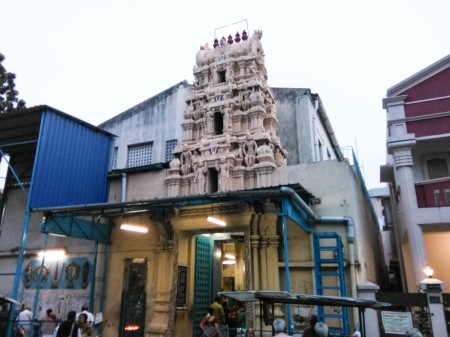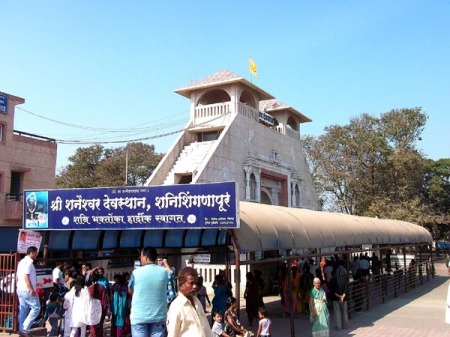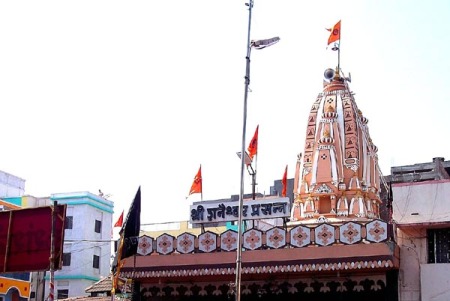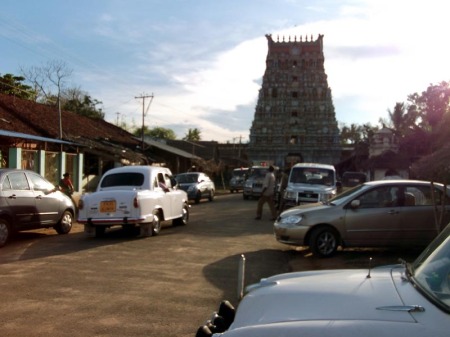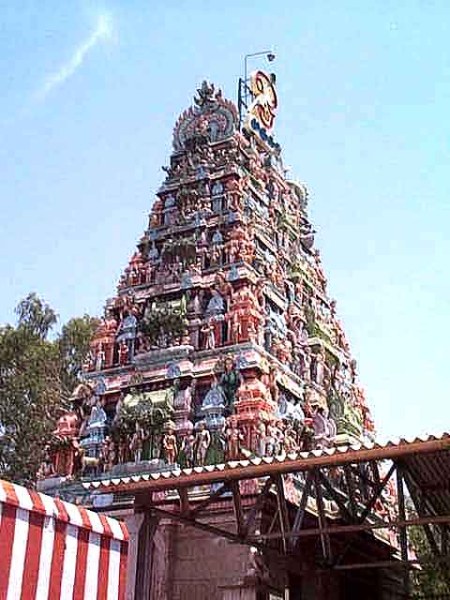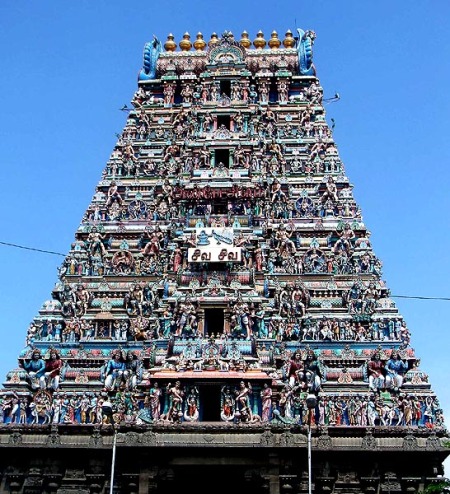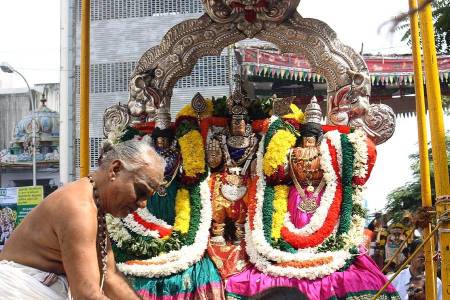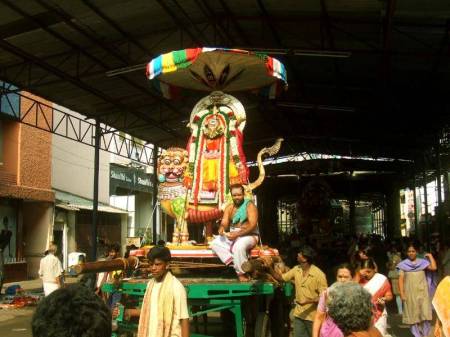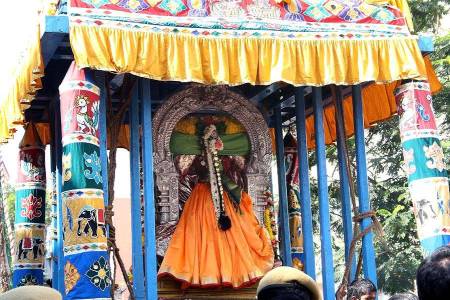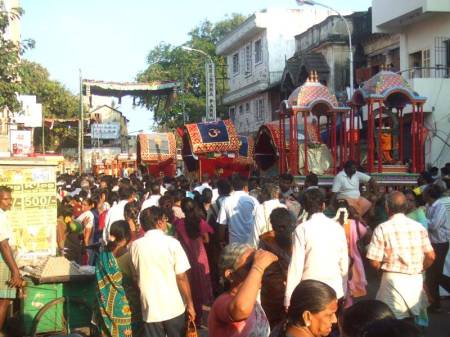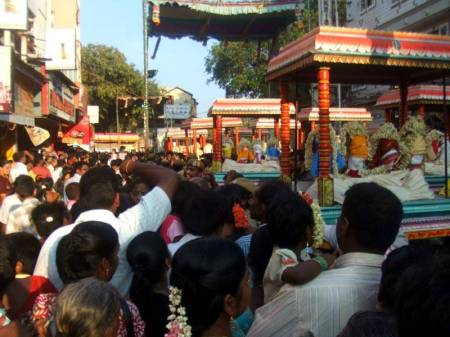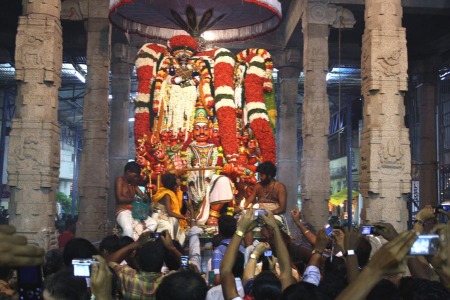TIRUVOTTIYUR
Tiruvottiyur is at a distance of 10 km north of Parrys corner or 18 km from Mylapore and is well connected by Rail and Road. There is a Railway station at a walkable distance from the temple. Also, frequent bus service is available from most parts of the city. The Thyagarajaswamy and Vadiyudai Amman temple is located off Tiruvottiyur high Road, a commercially busy highway with heavy movement of vehicles. Yet, when you enter the road leading to the temple, the scenario changes suddenly and you feel far away from the hustle and bustle of the near by market.

A view of the Thyagaraja Temple at Tiruvottiyur
Sri Thygarajaswamy temple at Tiruvottiyur is an ancient temple and is said to be the oldest temple on the Earth. The three prominent Saivaite saints, Appar, Sundarar, Tirugnanasambandar had sung in praise of the Lord of this temple. This temple has many distinct features and the important ones are mentioned here. The Tamil celebrity poet Kambar chose Tiruvottiyur to study the Valmigi Ramayanam in Sanskrit and to write his version of Kamba Ramayanam here.
The presiding deities are Siva and his consort Sakthi or Parvathi Devi. It is one of the three important Sakthi Sthalams in the city. The other two are, Kodiyidai Amman in Tirumullaivoil and Tiruvudai Amman in Melur, 3 km from Minjur. On a full moon day, devotees throng to having darshan at all these three temples. Firstly, they have the morning darshan of Ichha Sakthi at Melur, another Gnana Sakthi in the afternoon at Tiruvottiyur and the third Kriya Sakthi in the evening at Tirumullaivoil to complete the Sakthi Darshan.
Lord Siva is said to be in all three forms at this temple as per the verse:
அருவாய் உருவாய் அருவருவாகிக்
குருவாய் வரும் சக்திக்கோன்
He represents fire, one of the five elements of Nature and being the foremost God, he is called Adipuriswarar. This is formlessness and this sanathi is closed by a stone wall. The second is Thyagarajar, representing the form for ordinary people like us to see and worship the formless Lord. And the third is with both form and formlessness. He is called Padam Pakka Nathar. This form is represented by a ‘snake mound’ which has both form and formlessness. This is the ‘self-created’ state of God, called ‘Swambu Murthy’. The deity, Lord Siva has several names here and some of them are: Thyagarajar, Adipureeswarar, Padampakka Nathar and his consort, Parvathi Devi is known as Vadivudai Amman and Thrupurasundari
The Tiruvottiyur temple had been visited by sadhus, saints and other devotees in large numbers who had sung in praise of the Lord and some among them are Appar, Sundarar, Pattinathar, Ramalinga Swamigal, Kambar, Thyagarajar.
Appar’s verse on Tiruvottiyur deity:
ஓம்பினேன் கூட்டைவாளா உள்ளத்தோர் கொடுமை வைத்துக்
காம்பிலா மூழைபோலக் கருதிற்றே முகக்கமாட்டேன்
பாம்பின்வாய் தேரை போலப் பலபல நினைக்கின்றேனை
ஓம்பிநீ உய்யக் கொள்ளாய் ஓற்றியூர் உடையகோவே –அப்பர்
Ramalingar had sung 101 verses in praise of the Devi in Vadiyudai Manikka Malai, and 31 verses on Adipureeswarar
கடல் அமுதே செங்கரும்பே அருட் கற்பகக் கனியே
உடல் உயிரே உயிர்க்குள் உணர்வே உணர்வுள் ஒளியே
அடல் விடையார் ஒற்றியார் இடங் கொண்ட அருமருந்தே
மடல் அவிழ் ஞான மலரே வடிவுடை மாணிக்கமே – இராமலிங்க சுவாமிகள்
One of the eighteen Siddhars, Pattinathar wrote about Tiruvottiyur,
வாவியெல்லாம் தீர்த்தம்
மணல் எல்லாம் வெண்ணிறு
காவணங்கள் எல்லாம் கண நாதர்
பூவுலகில் இது சிவலோகம் – பட்டினத்தார்
The carnatic music maestro, Thyagrajar had sung five Kirthanas on this Devi, Vadiyudai Amman when he visited Tiruvottiyur on his way to Tirupathi.
1) கன்ன தல்லி நீவு நாபால க லுக ; 2) ஸுந்தரி நிந்நு . .3) ஸுந்தரி நந்நிந்தரிலோ . . 4) ஸுந்தரி நீ திவ்ய . . 5) தரிகி தெலு ஸுகொண்டி

- Temple Tower (note the Magizla tree)
The temple has a seven Kalasam, five tier tower with beautiful figures of God and Goddesses depicting the various stories in the scriptures. There are three Dwajastambams, one each before the shrine of Adipureeswarar, Vadiudai amman and Vattaparai amman.
There are two spacious shrines for the presiding deities and a number of small shrines also.The unpaved ground gives a natural look and takes one back to the olden times itself. The shrine of the Devi Vadivudi Amman is situated near the entrance with an attached stone pillar Mandapam. At the sanctum is the beautiful image of the Devi Vadiyudai Amman in standing posture facing the Southern direction.
The Lord Siva’s shrine houses Thyagarajar, the processional deity and Padam Pakka Nathar, the self created form which is normally covered with a Kavasam. The sanctum is semi circular in shape at the rear side. Both images of the Lord are facing the Eastern direction. The sanctums share a common closed Mandapam with a number of identical stone pillars of circular cross section. The sixty three Nayanmars are in the inner corridor.
By the side of the Siva’s shrine, is the Devi Vatta Parai amman. There is a circular stone alter before the Devi where Adi Sankarachariyar, worshiped and installed a Sri Chakram to pacify the once aggressive Kali Devi here. There is a separate entrance at the northern side of the main shrine for Vatta Parai Amman with a Dwajastambam.
The Sthala virukshams are Atthi tree and Magizla Tree. There is a famous story associated with this Magizla tree. This tree is visible even from outside the temple, through the entrance (Please see the photograph)
Legend has it that Sundarar after marrying Paavaiyar at Tiruvarur and living with her for some time, visited Tiruvottiyur, met Sangiliyar and fell in love with her also. Sangiliyar, who used to tie garlands for the Lord in the temple, also liked marrying him. Sundarar finding it embarrassing to marry for the second time at the temple, proposed this Magzla tree as the venue for their marriage. Their marriage took place at the Magizla tree and the Lord Siva appeared before them granting his darshan. These two marriages of Sundarar were in accordance with the love affair of the trio in Kailash before their birth and they were united here on earth as ordained by the Lord.
The other shrines within the complex are: Vinayakar, Murugar, Kuzanthi Easwarar, Gowleeswarar (Lizard God), Akasa Lingam, Navagrahas, ValarKali Amman, Ekapadha Murthy (God with one foot).
Another unique feature of this temple is the 27 small shrines in a row for all the 27 Nakshatras or Stars in the form of Lingams of various sizes. It is a common sight to see people coming here on their birth days and special occasions for performing archana on their behalf. All these 27 shrines are on the Southern side in the temple complex.
The Nandhi, the mount of Lord Siva is seen soon after the entrance and is kept on a high pedestal which is reached by a flight of steps. One can see the youngsters climbing up the steps and reaching the Nandhi to whisper their wishes into its ears for fulfillment.
Nearby temples:
Sri Dakshanamurthy Temple
A temple dedicated to Lord Dakshinamurthy is just before the Thyagarajar’s temple on the Sanathi Street. This temple has an impressive huge stone icon of Lord Dakshinamurthy in the meditation form facing north. The temple was undergoing major construction and renovation works (June 16, 2010) and the care takers there said the Kumbabishegam would be held shortly.
Kubera Lingam

Agasthiyar's Kubera Lingam Temple, Tiruvottiyur
There is another Siva temple at the junction of Tiruvotiyur high road and the Sanathi street leading to Thyagarajaswamy temple. The presiding deity is Kubera Lingam, said to have been worshiped by the sage, Agashiyar.
Pattinathar Samadhi

Pattinathar Samathi, Tiruvottiyur
There is a temple for the Sidhar, Pattinathar off the coastal high way near the seashore at Tiruvottiyur. It is here Pattinathar attained ‘Jeeva samathi’. Regular poojas are offered daily. There is an icon of Siva Lingam at the place of his Samathi. It is Pattinathar, the great Sidhar, who is often quoted for his following verse on the temporary nature of the mundane life in a very simple language which anyone can easily understand.
காதறுந்த ஊசியும் வாராது
காணும் கடை வழிக்கே
CSG Raju



 In the outer praharam
In the outer praharam



